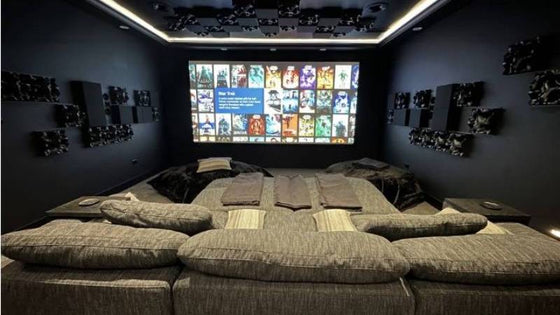Creating a system you love shouldn't be difficult. The Acoustic Frontiers blog is here to help.

This short, but SWEET, article will give you some tips on how to make sure your home theater delivers the sonic goods, giving you the best home theater sound your equipment is capable of.
This one is absolutely critical. Many people are simply using the wrong speakers in their home theater. If you are an enthusiast, and like listening at high SPLs, then there are very few speaker topologies that will reliably deliver the goods.
Do not use speakers with a single soft or metal dome tweeter. Multi-tweeter arrays are cool. Compression drivers on horns are better. Line sources work but are pricey. Anything else will give you stilted dynamics and poor reliability.

Compression drivers on horns. Yes, this IS high performance home theater 🙂
Throw those horizontal format center speakers away and get a center speaker that is identical to your left and rights. Then put it behind an acoustically transparent screen. See here for more.
For surrounds you should be using monopoles or bipoles, not dipoles*. Dipoles are expressly designed not to have consistent off axis dispersion. Why would you want that, especially with spatial audio formats like Dolby Atmos where an object may transition from front to back in a room through the null of the dipole.
* see this article about dipoles, monopoles and bipoles
Simply put any ears should be minimum 4ft away from any speaker. Do not put seats near walls, especially a back wall, or you’ll lose surround sound envelopment and get boomy bass as well. A seat too close to a surround speaker will result in excessive localization.
Do your seating layout before you choose your equipment. It should be the first thing you do! For more see our home theater seating layout article.
If you have one row of seats you need two subwoofers. If you have two rows of seats you need at least four subs and possibly more.
Having an horn loaded mega sub will not give you smooth bass. It will certainly give you a lot of it but you’ll also get massive peaks and dips across your listening area from rampant room modes and speaker boundary interference cancellations.
The pro tip is to use more subs, and to put them in certain “mode-cancelling” arrangements to provide consistent, smooth bass across your seating area. To learn about multiple subwoofers, run this search on google.
Your audio system is only one half of the sound you get. The other half is the room. Room acoustics are a minefield of conflicting opinion and armchair experts. Our advice is to make sure you do the basics.

The well treated side wall of The Savoy home theater that we designed.
Add enough bass trapping to get your room modes under control. Deep fiberglass traps are extremely effective and relatively cheap; the only downside is that they take up a lot of space. However most of you have a ton of space in your risers and behind your screen. Use it!
Once you’ve done that add just enough absorption to make your room sound nice. It should not sound “dead” or “echoey”. If you have a conversation with someone in your theater it should feel natural. Typically if you have wall-to-wall carpet and home theater seats you often don’t need much more absorption.
You can often do more harm that good treating first reflection points. Do some research and you’ll find that thin absorbers actually screw up your sound, stripping it of the high frequencies whilst leaving the mids and bass behind. Better in our opinion not to treat your room for first reflections than to put 1″ fiberglass everywhere.
So you’ve meticulously researched all your equipment and painstainkly built the home theater of your dreams. But what do you do at the end of it? Trust the results to some automated setup routine in your AVR or pre-pro? Please NO!
At a minimum do the basic setup yourself – speaker size, distances, levels, subwoofer integration. The automated routines get these wrong all the time. The THX baseline recommendation is to set all speakers to small and use an 80Hz crossover. That’s a great starting point, and nearly always better than what the AVR will suggest.

Typical “automatic” (purple) and properly set up (green) subwoofer / mains integration curves
If you want to maximize the return on your investment get a professional to do a proper audio calibration. Home Acoustics Alliance certification is what you are looking for. These guys and gals have the knowledge and tools to ensure everything is squeeze every last ounce of performance out of your theater.
Got anymore “no brainer” tips for getting the best sound from your home theater? Please add a comment below.
Learn how early home theater design, layout, and acoustic treatment improve performance in new home construction.
This media room was intentionally designed to feel like part of the home—not a separate, tech-heavy space. Through careful acoustic planning, equipment integration, and final calibration, we achieved a room that is both beautiful to live in and immersive to experience.
"No other subwoofer system I’ve owned even comes close to what this room delivers. Reaching out to Acoustic Frontiers was one of the best decisions I’ve made—I highly recommend working with them if you want to get the most out of your theater."

Nyal Mellor, Founder, Acoustic Frontiers



Nyal Mellor
Author